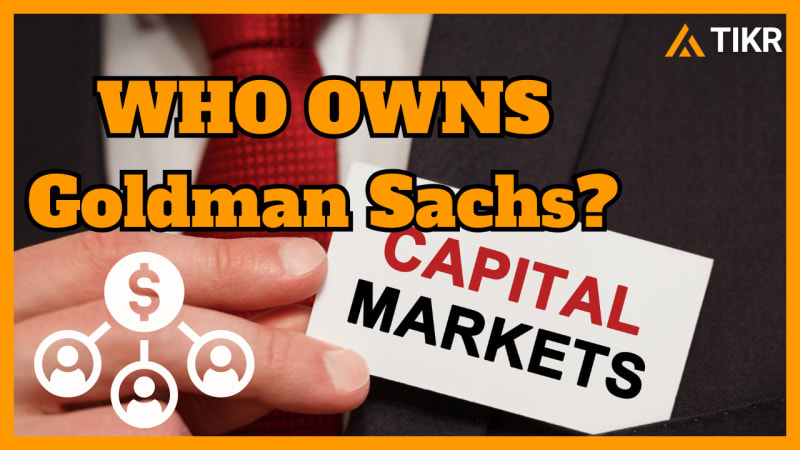Goldman Sachs Group, Inc. (NYSE: GS) is a global investment banking and financial services firm known for advising on mergers, underwriting securities, trading across markets, and managing assets for institutions and individuals worldwide.
The company has long been one of Wall Street’s most powerful names, recently trading around $731 per share with a market cap of roughly $211 billion. Shares have surged more than 46% over the past year, fueled by a rebound in capital markets, strong trading activity, and steady contributions from its asset management business.
Once known primarily as an elite investment bank, Goldman has evolved into a diversified financial powerhouse with global reach across investment banking, trading, wealth management, and consumer finance. Its brand, scale, and profitability make it one of the most influential institutions in global markets.
Ownership of Goldman is now heavily concentrated among major index funds and institutional investors, reflecting its role as a core holding in countless portfolios. While insiders such as CEO David Solomon and other top executives maintain meaningful personal stakes, the majority of shares are in the hands of large asset managers, sovereign funds, and long-term institutional holders.
Looking at who owns Goldman and what insiders are doing gives investors a glimpse of how big players are positioning around the stock after such a strong run.
Who Are Goldman’s Top Shareholders?

Track the top shareholders of over 50,000 global stocks (It’s free) >>>
Goldman Sachs stock is dominated by the world’s biggest asset managers, reflecting its role as a cornerstone of global index funds and institutional portfolios. These firms hold the largest stakes in the company, ensuring steady ownership and long-term stability.
Goldman’s Largest Shareholders
- Vanguard Group: 28.9 million shares (9.55%), worth $21.1 billion
- State Street Global Advisors: 19.5 million shares (6.43%), worth $14.2 billion
- BlackRock: 15.0 million shares (4.95%), worth $10.9 billion
Together, these three control over 20% of Goldman. Their positions are mostly index-driven, meaning demand for GS stock is steady regardless of short-term market swings.
One highlight from last quarter is Alyeska Investment Group’s aggressive move, increasing its Goldman Sachs stake by 317%. The firm now owns roughly $113 million worth of shares, signaling growing confidence in the bank’s outlook.
Other notable holders include Geode Capital (2.20%), Fisher Investments (2.16%), and JP Morgan Asset Management (1.71%). Rival Morgan Stanley also owns 1.24%, a unique dynamic showing even competitors want exposure.
Goldman is deeply embedded in index funds, making it a stable, long-term core holding in global portfolios. This level of passive ownership provides price support but also means the stock will largely track broad market trends.
See whether Goldman’s top shareholders are buying or selling today >>>
Goldman’s Recent Insider Trades

Like most large financial firms, Goldman’s insider activity is closely watched as a signal of management’s confidence. Recent Form 4 filings show several executives trimming their holdings this summer.
Insider Trades
- Denis Coleman (CFO): sold 7,400+ shares in July at $724–$728
- John Rogers (Chief of Staff): sold 18,000+ shares, worth about $13 million
- David Solomon (CEO): sold roughly 6,600 shares at ~$712
These sales appear like planned transactions or diversification, rather than sudden moves. Importantly, there has been no notable insider buying during this period.
Insider selling on its own doesn’t necessarily point to weakness, but the lack of insider buying may signal that leadership sees the stock as fairly valued after a strong rally.
For investors, it’s worth keeping an eye on future filings to see if sentiment shifts toward buying, which could reflect greater confidence in near-term upside.
See recent insider trade data for over 50,000 global stocks (It’s free) >>>
What the Ownership & Insider Trade Data Tell Us
Goldman Sachs’ shareholder base shows a clear split between long-term passive investors and active managers adjusting positions after the stock’s rally. This mix offers stability from index fund ownership, while active flows reflect shifting market views.
Key Takeaways
- Institutional stability: Vanguard, State Street, and BlackRock anchor Goldman’s ownership. Their passive inflows provide steady demand and long-term support.
- Active manager divergence: Some, like Capital World and JP Morgan, trimmed stakes, while Norges Bank boosted its position. This suggests no consensus view, with strategies varying by fund.
- Insiders leaning cautious: Executives have mostly sold shares, which looks like diversification or routine trading. The absence of insider buying could imply leadership is comfortable holding but not aggressively adding.
Goldman remains a stable, institutionally backed stock. Its large passive base helps smooth volatility, but insider selling and mixed institutional moves show that near-term upside will likely depend more on earnings momentum and market conditions than conviction buying from management.
Wall Street Analysts Are Bullish on These 5 Undervalued Compounders With Market-Beating Potential
TIKR just released a new free report on 5 compounders that appear undervalued, have beaten the market in the past, and could continue to outperform on a 1-5 year timeline based on analysts’ estimates.
Inside, you’ll get a breakdown of 5 high-quality businesses with:
- Strong revenue growth and durable competitive advantages
- Attractive valuations based on forward earnings and expected earnings growth
- Long-term upside potential backed by analyst forecasts and TIKR’s valuation models
These are the kinds of stocks that can deliver massive long-term returns, especially if you catch them while they’re still trading at a discount.
Whether you’re a long-term investor or just looking for great businesses trading below fair value, this report will help you zero in on high-upside opportunities.
Click here to sign up for TIKR and get our full report on 5 undervalued compounders completely free.

